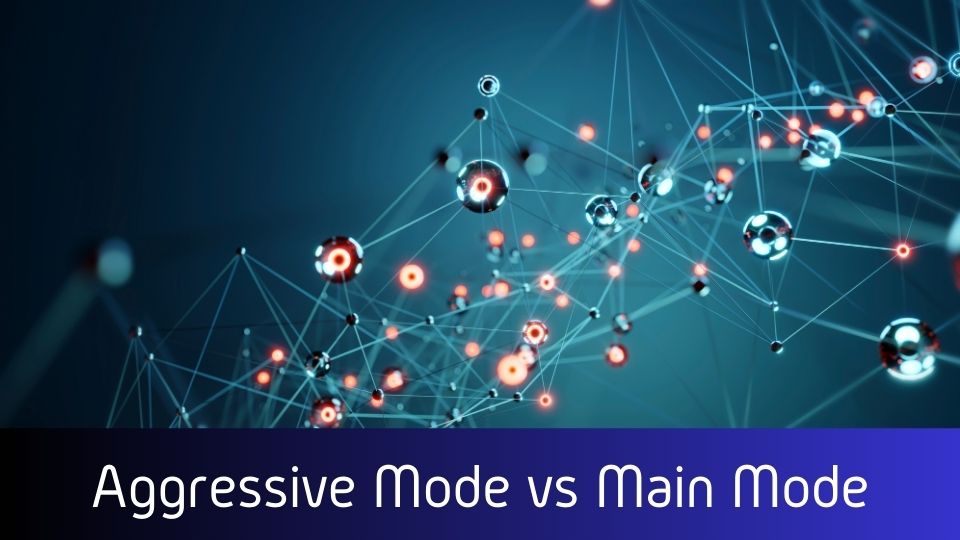In the realm of network security, understanding the nuances and operational specifics of protocols like IKEv1 is paramount for securing data transmissions over virtual private networks (VPNs).
IKEv1, a cornerstone in the establishment of secure VPN connections, offers two distinct negotiation modes: Main Mode and Aggressive Mode.
These modes, while serving the same end goal of securing data exchange, diverge significantly in their approach, with implications for both speed and security.
This blogpost aims to demystify these modes, providing a clear comparison of Main Mode and Aggressive Mode, their respective use cases, and the security considerations each entails.
For professionals navigating the complex landscape of network security, especially those utilizing or considering Cisco's Next-Generation Firewall (NGFW) Firepower Threat Defense (FTD), understanding these modes is critical.
Our discussion will not only shed light on the technical intricacies of these modes but also guide you in making informed decisions suited to your security needs and network architecture.
As we delve into the specifics, remember that the choice between Main Mode and Aggressive Mode can significantly impact the robustness and efficiency of your VPN configurations.
By the end of this article, you'll be equipped with the knowledge to select the mode that best aligns with your security posture and performance requirements.
Understanding IKEv1
IKEv1 (Internet Key Exchange version 1) plays a crucial role in the secure establishment of VPN tunnels, facilitating encrypted data transmissions between networks. By negotiating security associations (SAs) and cryptographic keys, IKEv1 ensures that data exchanged over VPNs remains confidential and tamper-proof.
For an in-depth exploration of Cisco's NGFW and its capabilities, consider exploring our comprehensive course on Cisco NGFW Firepower Threat Defense (FTD), designed to enhance your expertise and operational efficiency in managing Cisco's security solutions.
Importance of IKEv1 in Secure Communications
The secure configuration of VPNs via IKEv1 is fundamental for protecting data against unauthorized access and eavesdropping. By offering a structured protocol to establish and renew encryption keys, IKEv1 forms the backbone of secure VPN communications, catering to the evolving security needs of modern networks.
Main Mode
Main Mode operates through a six-message exchange process, meticulously safeguarding the identities of the communicating parties through encryption. This mode is synonymous with robust security measures, ensuring that critical information remains concealed during the negotiation phase.
Use Cases for Main Mode
Main Mode is the go-to choice in scenarios where identity protection and security are paramount. Its structured negotiation process makes it suitable for static IP environments, where the slight delay introduced by its thoroughness is a worthy trade-off for enhanced security.
Aggressive Mode
Aggressive Mode simplifies the negotiation process to just three messages, significantly speeding up the establishment of the VPN connection. Unlike Main Mode, it does not encrypt the identities of the negotiating parties in the initial messages, which can have implications for security but benefits the connection time.
Use Cases for Aggressive Mode
Aggressive Mode is particularly useful in scenarios where speed is a critical factor or when dynamic IP addresses are involved. Its ability to quickly establish VPN connections makes it ideal for situations requiring rapid, on-demand secure communications, such as remote access for mobile users.

Security Implications and Considerations
When comparing the security aspects of Main Mode and Aggressive Mode, it's important to recognize that the expedited process of Aggressive Mode comes at a potential cost to security. The mode exposes identity information in the clear until the security association is established. Main Mode, conversely, maintains confidentiality throughout the negotiation process, making it a more secure option for sensitive communications.
Vulnerabilities and Mitigation
The most significant vulnerability in Aggressive Mode arises from its handling of identity information and negotiation details in plaintext in the initial messages. This exposure can potentially be exploited for various attacks, including man-in-the-middle (MITM) attacks. To mitigate these risks, employing strong, unique pre-shared keys and considering the deployment of Main Mode in high-security environments are recommended strategies.
Decision Factors in Mode Selection
Selecting between Aggressive and Main Mode requires a careful evaluation of your network's security needs, performance requirements, and the nature of the data being protected. Factors to consider include:
- Security requirements: Main Mode is preferable for environments where identity protection and data security are paramount.
- Network architecture and IP environment: Aggressive Mode can offer advantages in dynamic IP scenarios or where rapid VPN establishment is necessary.
- Performance considerations: The speed advantage of Aggressive Mode may be beneficial for certain applications, balancing the slight compromise in security with operational efficiency.
Recommendations for Network Administrators
For network administrators and security professionals, the choice between Main Mode and Aggressive Mode should align with the organization's security posture and operational needs. While Main Mode offers a higher level of security, Aggressive Mode provides speed and flexibility in environments where these are critical factors. Regularly reviewing and adjusting VPN configurations in response to evolving security threats and network requirements is essential for maintaining robust protection.
Summary
In the intricate dance of network security, the choice between IKEv1's Main Mode and Aggressive Mode is not merely a technical decision but a strategic one, balancing the scales between speed and security.
Main Mode, with its robust encryption and identity protection, stands as the bulwark for environments where security cannot be compromised.
Conversely, Aggressive Mode offers a swift alternative, advantageous in scenarios requiring rapid deployment and flexibility, albeit with a nuanced understanding of its security limitations.
For network administrators, security professionals, and IT enthusiasts navigating the vast seas of cybersecurity, the decision hinges on a deep understanding of their network's architecture, the sensitivity of the data in transit, and the overarching security posture of their organization.
As threats evolve and new vulnerabilities emerge, the choice between these modes may shift, underlining the importance of adaptability and ongoing education in the field.
Enhancing one's knowledge and skills, particularly through specialized courses like our Cisco NGFW Firepower Threat Defense (FTD), can provide the insights needed to navigate these decisions effectively. In the end, the goal is to ensure the integrity, confidentiality, and availability of data across networks, a mission that demands both vigilance and a profound understanding of the tools at our disposal.


